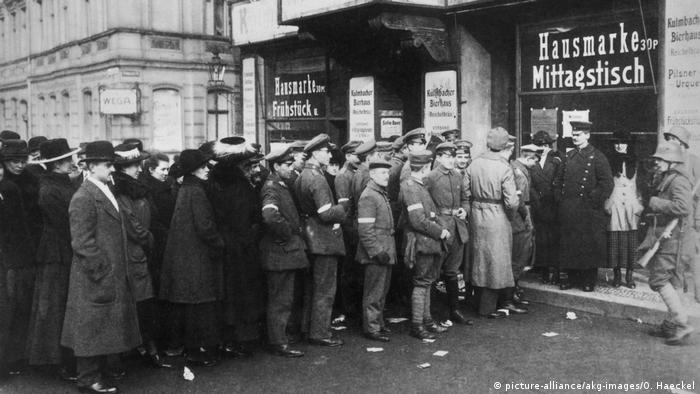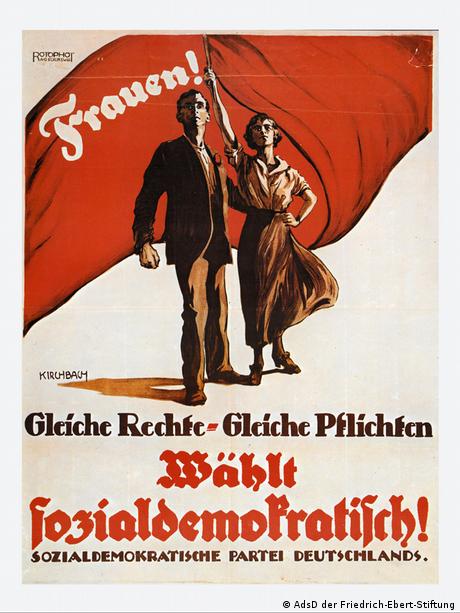Are not allowed to choose, the Germans in the Imperial period, however, all. After the fall of the monarchy, the Parliament is the centre of power and a modern Constitution. Your biggest enemy is Adolf Hitler.

Standing in line for democracy in front of a Berlin polling station on may 19. January 1919
“Everything for the people, by the people!” the social Democrat (SPD) calls on Philipp Scheidemann on 9. November 1918 from the balcony of the Reichstag in Berlin. On this day, he proclaimed the Republic, which is initially a temporary. Because people must choose only two months later, on 19. January 1919. In the meantime, a Council of the popular government officers, under the leadership of the SPD Chairman Friedrich Ebert. Its task is to ensure the Transition from the monarchy to the parliamentary democracy.
On the way there, to die in the German revolution of winter, several Thousand people in a civil war-like conditions. Among the Victims were Rosa Luxemburg and Karl Liebknecht, founded at the turn of the year, the Communist party of Germany (KPD). You are four days before the election for the national constituent Assembly is murdered. The birth of democracy in Germany is under no good star. In December 1918, the SPD decides-dominated Imperial Council Congress and its self-removal from power, thus paving the way for the first General, equal, secret and direct election.
For the first time, women are allowed to choose

And there is a second Premiere: women have the active and passive right to vote. In addition, the voting age is lowered from 25 to 20 years. The hope of the SPD an absolute majority remains unfulfilled. While it is 37.9 per cent, and a large margin the strongest force, but relies on coalition partners. You will find in the conservative, Catholic-dominated centre party and the left-liberal German Democratic party (DDP).
Communist deputies there are none, because the KPD, the choice remains remote. A participation would have been in her eyes a betrayal of the Revolution. Rosa Luxemburg had in vain advised not to boycott the election. Unlike many of their companions, the figurehead didn’t believe many of the Linker to a quick victory of the Revolution, says Hamburg-based historian Marcel Bois in an interview with Deutsche Welle. “Luxembourg has recognised that the SPD is still the most powerful force in the labor movement.”
The political map is overwhelmingly red
Because election campaigns are always places to be in the political debate, it is necessary to be a Communist is also part of it and join debates, have argued – in vain. By the voluntary resignation of the KPD, the SPD and the Independent social Democrats (USPD) but only to a limited extent. Even more disappointing, the results for those parties, the face of the young Republic critical to dismissive. The right-liberal German people’s party (DVP) and the conservative German national people’s party (DNVP) together receive less than 15 percent.

“The greatest part of Germany is red”, refers to historian Marcel Bois on the coloring of the political map. Almost everywhere, the SPD won the election circles. In the Halle-Merseburg, at the time, the German industrial center, it is the USPD. In the Catholic South, however, so in Bavaria, and in the Catholic West, the Republic is black. There, the centre party and the Bavarian people’s party are at their strongest. In the East there are areas, where the populist, anti-Semitic DNVP is the strongest force.
From the Splitter to the mass party: NSDAP
On 6. February, a good two weeks after the election, the national Assembly for the first time – but not in Berlin, but in the tranquil town of Weimar (Thuringia). The still hot mood in the Empire’s capital appears to be most of the 423 deputies, including 37 women, to dangerous. Historian Marcel Bois sees in this decision, no blemish. “I think, since political developments of the next few years have had a much greater importance.”

On 6. February takes place the historic place in Weimar, a ceremony with Federal President of Germany Frank-Walter Steinmeier
The 1920 by Adolf Hitler in Munich, in the national one, especially socialist German workers party (NSDAP). They develops about ten years later, against the Background of the world economic crisis from a sliver to a mass party. Her triumph culminates in 1933 in the course of after their place of origin named the Weimar Republic. The Nazi-party of the liberal Constitution, which will be developed by the first elected national Assembly until the summer of 1919 and decided to benefits.
The principle of the separation of powers
Even today, the separation of powers between Parliament, government and jurisdiction in the Federal Republic of Germany and is mainly regulated in such a way as back then – with the important difference that the President has Power in the Weimar Republic much more than it is today. The only reason Paul von Hindenburg to appoint 1933 Adolf Hitler was legally appointed Chancellor. Since 1949, the role of the head of state is limited in the core on a representative role as a direct lesson from the Failure of the first German democracy.